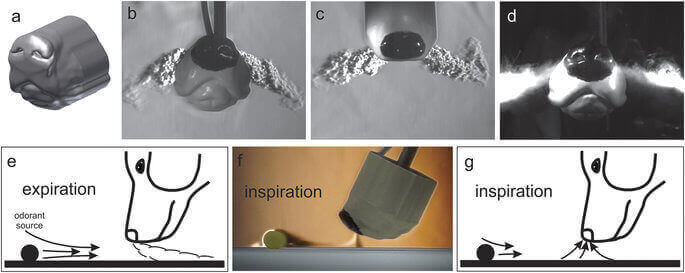Researchers fitted a 3D printed dog’s nose to an explosives detector, reporting up to 18 times better functionality for chemical detection.
There’s a new way to detect narcotics, explosives, and even human presence. It seems man’s best friend is leading the way for American scientists like Matthew Staymates.
His inspiration? A loveable little dog named Biscuit. More specifically — Biscuit’s nose.
He found that adding a 3D printed dog nose to the end of an explosives detector nozzle works better than a regular device ‘sans snout.’
Researchers used high-speed imagery to suss out how dogs use their noses for tracking. Staymates led the research at the US National Institute of Standards and Technology.
He explains the “active sniffing” technique in an interview with ResearchGate.
“The geometry of the nose and nostrils, coupled with the directionality of air when the dog exhales, allows the dog to ‘reach out’ and grab odors from fairly large distances,” he says.
The research shows that dogs can decode smells using around 300 million receptor cells. So, Staymates designed a nose-like nozzle for an explosives detector. Then, he printed the design using a Objet500 Connex3 3D printer.
The 3D print imitates a dog’s nose in a process called Biomimicry. That means that the technological solutions are based on something already found in nature.
Watch the video below to hear Staymates explain:
3D Printed Dog’s Nose Sniffs Out Hazards
To research artificial dog noses, the researchers used a Schlieren Optical system. This is a visual process that photographs the flow of fluids.
Due to the geometry of a dog’s nose, the researchers found that “aerodynamic reach” occurs at a higher rate than with regular vapor detectors.
Dogs sniff approximately every ten seconds while exhaling at the same time. Regular vapor detector machines inhale air continuously – this limits aerodynamic reach.
Staymates continues:
“Once we learned how the dog was sampling air during sniffing, we designed and 3D printed nostril-like features that mimic the sniffing pattern of a real dog. We then attached it to the inlet of a commercially available explosive vapor detector, essentially making the instrument sniff like a real dog rather than use continuous inhalation.”
To test out the sampling performance, researchers recorded measurements with the instrument. Using acetone vapors, they tried out the device in standard operating mode vs. sniffing mode. Under experimental conditions, researchers proved that sniffing was better up to a factor of 18.
Want to find out more? The new research was recently published in Scientific Reports.
Source: ResearchGate

License: The text of "3D Printed Dog’s Nose Improves Effectiveness of Explosive Detectors" by All3DP is licensed under a Creative Commons Attribution 4.0 International License.